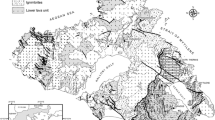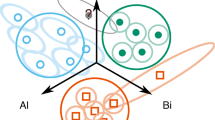Abstract
The National Uranium Resource Evaluation (NURE) Program has as its goal the estimation of the nation's uranium resources. It is possible to use discriminant analysis methods on hydrogeochemical data collected in the NURE Program to aid in formulating geochemical models that can be used to identify the anomalous areas used in resource estimation. Discriminant analysis methods have been applied to data from the Plainview, Texas Quadrangle which has approximately 850 groundwater samples with more than 40 quantitative measurements per sample. Discriminant analysis topics involving estimation of misclassification probabilities, variable selection, and robust discrimination are applied. A method using generalized distance measures is given which enables the assignment of samples to a background population or a mineralized population whose parameters were estimated from separate studies. Each topic is related to its relevance in identifying areas of possible interest to uranium exploration. However, the methodology presented here is applicable to the identification of regions associated with other types of resources.
Similar content being viewed by others
References
Agterberg, F. P., 1974. Geomathematics: Elsevier Scientific Publishing Co., New York.
Amaral, E. J., 1979, NURE Plainview quadrangle, Texas: Bendix Field Engineering Corporation, Grand Junction Operations, Grand Junction, Colorado, GJQ-001.
Anderson, T. W., 1958, An introduction to multivariate statistical analysis: John Wiley & Sons, New York.
Arendt, J. W., Butz, T. R., Cagle, G. W., Kane, V. E., and Nichols, C. E., 1979, Hydrogeochemical and stream sediment reconnaissance procedures of the uranium resource evaluation project: Union Carbide Corporation, Nuclear Division, Oak Ridge Gaseous Diffusion Plant, Oak Ridge, Tennessee, K/UR-100.
Barr, A. J., Goodnight, J. H., Sall, J. P., and Helwig, J. T., 1976, A user's guide to SAS76: SAS Institute, Inc., Raleigh, North Carolina.
Beauchamp, J. J., Begovich, C. L., Kane, V. E., and Wolf, D. A., 1979, Application of discriminant analysis and generalized distance measures to uranium exploration: Union Carbide Corporation, Nuclear Division, Oak Ridge Gaseous Diffusion Plant, Oak Ridge, Tennessee, K/UR-28.
Dixon, W. J. and Brown, M. B., BMDP-77, 1977, Biomedical computer programs P-series: University of California Press, Berkeley, California.
Gnanadesikan, R., 1977, Methods for statistical data analysis of multivariate observations, John Wiley & Sons, New York.
Habbema, J. D. F. and Hermans, J., 1977, Selection of variables in discriminant analysis by F-statistic and error rate: Technometrics, v. 19, p. 487–493.
Huber, P. J., 1977, Robust covariances, statistical decision theory and related topics II: Academic Press, New York.
Lachenbruch, P. A., 1975, Discriminant analysis: Hafner, New York.
Lachenbruch, P. A. and Goldstein, M., 1979, Discriminant analysis: Biometrics, v. 35, p. 69–85.
McCabe, G. P., Jr., 1975, Computations for variable selection in discriminant analysis: Technometrics, v. 17, p. 103–109.
McCabe, G. P., Jr., 1979, Personal communication.
Randles, R. H., Broffitt, J. D., Ramberg, J. S., and Hogg, R. V., 1978a, Discriminant analysis based on ranks: J. Amer. Stat. Ass., v. 73, p. 379–384.
Randles, R. H., Broffitt, J. D., Ramberg, J. S., and Hogg, R. V., 1978b, Generalized linear and quadratic discriminant functions using robust estimates: J. Amer. Stat. Ass., v. 73, p. 564–568.
Rao, C. R., 1965, Linear statistical inference and its applications: John Wiley & Sons, Inc., New York, p. 435–513.
Uranium Resource Evaluation Project, 1978, Hydrogeochemical and stream sediment reconnaissance basic data for Plainview NTMS quadrangle, Texas: Union Carbide Corporation, Nuclear Division, Oak Ridge Gaseous Diffusion Plant, Oak Ridge, Tennessee, K/UR-101. United States Department of Energy, Grand Junction, Colorado [GJBX-92(78)].
Uranium Resource Evaluation Project, 1978, Procedures manual for groundwater reconnaissance sampling: Union Carbide Corporation, Nuclear Division, Oak Ridge Gaseous Diffusion Plant, Oak Ridge, Tennessee, K/UR-12. United States Department of Energy, Grand Junction, Colorado [GJBX-62(78)].
Author information
Authors and Affiliations
Additional information
This manuscript was prepared under contract W-7405-eng-26 of the U.S. Department of Energy.
Rights and permissions
About this article
Cite this article
Beauchamp, J.J., Begovich, C.L., Kane, V.E. et al. Application of discriminant analysis and generalized distance measures to uranium exploration. Mathematical Geology 12, 539–558 (1980). https://doi.org/10.1007/BF01034743
Received:
Revised:
Issue Date:
DOI: https://doi.org/10.1007/BF01034743




